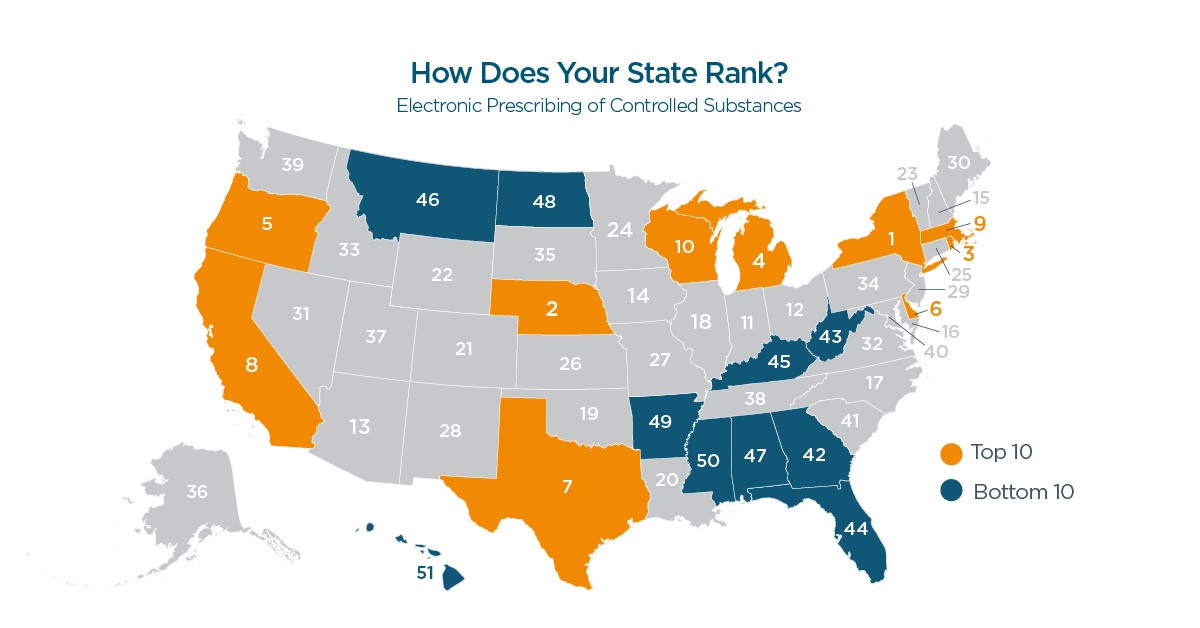The Centers for Disease Control and Prevention (CDC) recently released new clinical guidelines to improve the process for prescribing controlled substances. However, there is another important step providers can take to combat the nation’s opioid epidemic: digitizing the process with Electronic Prescribing for Controlled Substances (EPCS).
With EPCS, prescribers can close critical security gaps while ensuring that patients who rely on these medications to manage their chronic pain still have access to them. While it wasn’t until August 2015 that EPCS finally became legal in all 50 states and D.C., New York and others have been making progress for years.
Despite the time it took to legalize EPCS nationwide, legislation can be a catalyst for technology enablement. For example, before and after its I-STOP mandate took effect, New York set the bar for nationwide adoption. As we shared in our 2015 National Progress Report, in 2014, the majority of pharmacies in New York (70%) were EPCS-enabled. That number jumped to more than 91% in 2015, and puts New York at number-one in the nation for EPCS pharmacy enablement. Similarly, in 2014, less than 2% of prescribers were EPCS-enabled in New York, compared to almost 27% in 2015. 
In contrast, as of 2015, Nebraska was ranked number-two in the nation, with 82% of pharmacies enabled. However, only 15% of Nebraska’s prescribers could say the same. In fact, only 20% of Nebraska’s controlled substance prescriptions were electronic in 2015—far fewer than New York’s 38%. This gap alone suggests just how big an impact legislation can have on driving EPCS adoption at the state level.
While we can learn from progress in states like New York, as the data shows, there is still a large discrepancy between EPCS-enabled pharmacies and EPCS-enabled prescribers. This makes industry awareness on the topic all the more important, ensuring that prescribers have easy access to the information and resources they need to transition from being an e-prescriber to an EPCS user, effectively leading the fight against prescription opioid fraud and abuse.
As we follow the nation’s progress and anticipate where we’ll be at the end of this year, we’ll pay particular attention to states like Maine and New Jersey that have either passed or are actively trying to pass EPCS legislation.
Just weeks after New York’s EPCS regulations took effect in March 2016, Maine passed similar legislation slated to take effect in July 2017. Given that in 2015, Maine’s EPCS enablement ranking was thirtieth in the country—with less than 2% of controlled substances electronically prescribed—we look forward to seeing the state’s progress over the next year toward joining New York, Nebraska, Rhode Island, Michigan and Delaware as the nation’s most progressive EPCS adopters.
Check out the 2015 National Progress Report for a more in-depth look at national EPCS enablement and adoption rates, and to hear first-hand perspectives on how the technology is making a measurable difference in prescribers’ and patients’ lives. In this report, we take a deep dive into health information exchange and industry connectivity trends, from growing e-prescribing adoption and demand for electronic access to patient health history, to using smart tools like electronic prior authorization to improve care quality and delivery for both patients and providers.
Be sure to follow @Surescripts for more updates from the National Progress Report and the latest EPCS news.


 Dean Riggott Photography
Surescripts
Dean Riggott Photography
Surescripts
